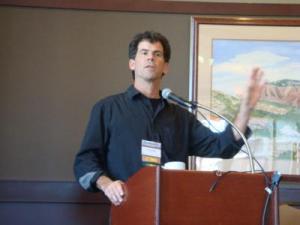By Chris Palmer
Led Zeppelin’s “Kashmir” greeted receptive attendees of David Dobbs’ Saturday afternoon workshop “Going Long: How to Structure the Longform Narrative – with Help From Music, Theater, and Film.” Dobbs played portions of the track, an example of the rock pioneers’ exploration of song structure, to kick off a fascinating talk and discussion about the use of form and structure in longform narrative stories.
In his opening remarks, Dobbs explained that longform stories cannot be written merely as scaled-up versions of short or mid-length stories. They require a different structure to keep the reader engaged.“Music, theatre and film offer analogous models of thinking about how to move stories along, how to structure them, how to transition from one part of the story to another,” said Dobbs.
Dobbs also played portions of pieces by Mendelssohn and Schubert in discussing the inspiration he draws from “sonata form, “ a musical structure dating back to the mid 18th century. Paralleling the progression of a feature narrative, sonata form has three main sections. Themes are introduced in the “exposition,“ elaborated and contrasted in the “development,“ and revisited in the “recapitulation“ in a way that changes how we think about the initial part of the song, giving it a deeper meaning.
Within the simple three-part structure of sonata form, there can be complex substructures. “There’s a macro structure where a piece is cut into a few big chunks which are broken into other structures that may replicate the bigger structure or may not,” said Dobbs, making an analogy between longform narrative structure and the structure of fractals.
The notion of long narratives resembling musical structures came to Dobbs while writing his third book. At the time, he was studying violin and his teacher implored him to use different notes and timbres to differentiate the various sections of the song. Dobbs soon recognized how to apply this mode of thinking to his writing.
“I had been missing the opportunity to use structure as an expressive force,” Dobbs recalled.
Dobbs also talked about finding inspiration in film techniques. “You can signal a transition just by being real up close and then pulling back.”
Story narrative can be zoomed in by slowing down the action (via the use of heavy detail) or zoomed out (compressing hours of action into one or two sentences). Changing the emotional tone or the density of language can have similar effects.
Finally, Dobbs described how the structure of theater guides structural decisions. “Do you want to introduce all the exciting characters in the first five minutes? Hell no. You need to save some for the second act. Somewhere near the 50 percent mark you need to introduce something new to refresh the reader’s attention.”
Dobbs used two of his longform narrative stories from the New York Times Magazine, as well as Michael Lewis’ longform analysis of the Greek financial meltdown, to illustrate various ways to manipulate structure. These stories, along with Dobbs’ annotations breaking down the stories’ structures, can be downloaded here.



